|
|
|
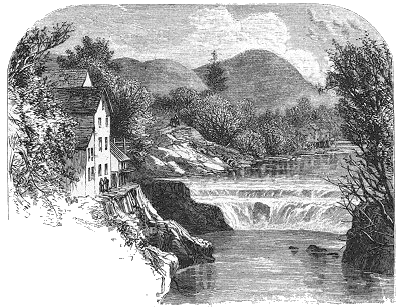
At The Gateway Of The Catskills - Part 1
by Ernest Ingersoll from May 1877 Harper's New
Monthly Magazine
The situation of Shokan, or Ashokan, as the
Indians pronounced it, supplies me with a title at once pleasing and
truthful. Here in the heart of Ulster County is a little hamlet of
widely scattered houses, separated by fields of corn, rye, oats, and
buckwheat, and half hidden in old orchards. The "Centre" is
a mile eastward of the creek, and "West Shokan" is the name
of the railroad station, where there is a brick hotel, two or three
country stores, a lumber mill, a church with an ambitiously high
steeple, a number of carriage sheds clustered about, and a few
houses, which seen as though they would be glad to get away. The
Ulster and Delaware Railroad, a local line northwestward from
Rondout, traverses the valley, and spoils the clearness of the air
with clouds of sulphurous coal smoke.
Leaving the staring group of rustics lounging
at the station, I hurried up the track a mile or so, to a farmer's
house that I knew of. It was a large square house, standing with it's
side to the road, and built with stone, hidden under the accumulated
layers many seasons' whitewashing. In front was generous porch, and
behind, a newer frame extension for a kitchen. It stood not far back
from the road, where was an immense immense horse-block, almost as
hard to mount as the horse itself, and in the small front yard were a
few flowers, fenced off from the vegetable garden on the left and the
orchard on the right, beyond which were the great barns and sheds.
Out in the road in front was the "shop", for in this
isolated village every man is his own artisan as well as cultivator.
"Mon" (short for De La Montaigne) Dorrs was at work there
as I came up - a short, somewhat bent man of sixty years, with a
keen, cunning countenance and a perpetual smile. He was always
good-natured and always busy, caring little for anything off his
farm, reading almost nothing, talking only of the weather and the
crops and the local politics; an old fashioned Democrat and good
neighbor, he was a type of the best Shokan farmers, and his home a
type of their homes. They seem to be utterly devoid of all ambition
beyond shelter and food, and to take no more interest in the
glittering world moving by than the average New Yorker does in a
militia regiment marching down Broadway. |
|
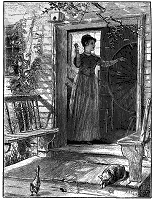 |
In the shop were a carpenter's tool chest, a
cooper's horse and shaving knives, a blacksmith's forge and anvil,
and some harnessmaker's implements. It was not an exceptional shop. A
young farmer's education is not considered complete here until he has
a sufficient knowledge of every trade having application to his labor
to provide himself of any needed commodity for his daily work. On the
other hand, the women all learn and daily practice the spinning of
wool and flax, and the weaving of carpet and coarse cloth on looms
which their husbands manufacture at home. In that summer of
"Centennial" experiences and uproar it was a treat to find
a community within one hundred miles of the metropolis where the
customs of Revolutionary days had scarcely worn off at the edges. |
|
The valley is several miles long and
irregularly broad, but with a level surface. The soil is coarse drift
bowlder material, and water-worn stones from an ounce to a ton in
weight are every where to be seen. Stone Walls, consequently , almost
entirely take the place of fences, which become browned by exposure
to the weather, embroidered with varicolored lichens, entangled in
thickets of briers, where lightly rests a mantle of snow blossoms, or
droop rich clusters of delicious berries, or glow sunburned masses of
foliage, and tumble into careless piles, exceeding picturesque the
year round. They are the favorite resorts of sparrows and wrens,
whose little bright forms dodge in and out of their hiding-places
with ceaseless activity, or choose some taller bush near by as a
pedestal for joyous song. On every side rise hills to the height of
fifteen hundred to two thousand feet, culminating at Shokan in the
two mountains, Tys ten Eyck and High Point, that stand over against
one another at the head of another valley, like two giant warders
guarding the portal to the mysteries of the Catskills, which the far
blue summits beckon feet and imagination to explore. |
|
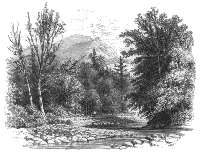 |
Through this huge gate and down the valley
winds the Esopus, named, or at least is supposed to be, after the
sub-tribe of the Iroquois Indians which had their hunting ground
here. It is a stream as wide as Broadway and very picturesque. In the
upper part of the valley it is filled with bowlders, so that one may
almost cross it dry-shod. You think you can quite do so, but there is
always a channel in the middle too wide to step over. Below, the
water encounters an outcropping ledge of rocks, over which it takes
three giant leaps, a score of feet down at each leap and plunges at
last into a circular basin of unknown depth and Stygian blackness. |
|
Here the water boils up from the bottom, and
then swings steadily out between perpendicular walls of green and
gray rock. It is like a miniature Niagara, more like some of the
little canons near the headwaters of the Rio Grande, which hardily
deserve notice among the grander gorges through which that troubled
river finds it ways out to the Llano Estacado. The Esopus, from
source to outlet at Saugerties, is a brawling mountain stream, such
as the painters go to Scotland to find; or rather it was before the
forests on its banks were felled and its waters befouled by refuse
from the tanneries, mills, and villages, which, attracted by its bark
and lumber, have grown up on its banks. But to follow up any of its
small tributaries, like the Little Beaverkill or the Bushkill, or to
work your way to its source, is to penetrate the primeval forest,
where, now that the bark-peelers have departed, rarely wanders any
but the trapper or trout-fisher, or an occasional tramp like the
writer, who would seek for the love of them the inmost recesses of
the wilderness.
Through the gateway about the beginning of the
century passed many of the settlers of Delaware County, which lies
thirty miles to the northwest, coming from Long Island, Connecticut,
and from the counties beyond the Hudson. Down through it now comes a
large part of the produce, mainly butter, from that county to market.
The settlers beyond the mountains have also sent back a man or two
into the world who have emerged from these mountain portals. But
little over twenty years ago a youth, the son of a farmer, was in the
district school there, in the edge of Delaware, who has since become
a sort of Napoleon in the world of stocks, and whom Wall Street fears
and admires. A lad, his school-mate and playfellow, now "an
author and naturalist of pleasant fame", also followed the
Esopus down out of the mountains, seeking the great world beyond, and
reversing the movement of his ancestors at the beginning of the century.
If searching varied scenery nearer the village
of Shokan, you must not fail to walk two miles down to Bishop's
Falls, to which I alluded a moment ago, where the Esopus leaps into
its little canon. To get the complete picture, you must climb down to
the foot of the falls - cautiously, for the rocks are slippery with
spray and slimy confervoid growths. Beside you is the deep dark pool
where the fish love to lie; over your head, the long, covered,
age-colored bridge, spanning the chasm from abutments of living rock;
in front, the rock amphiteatre, raised still higher by a log dam at
the top, down whose steps rushes the tumultuous water, white with the
foam of its mad leap, and hoarse with the thunder of its breaking
waves. On your right is an old tannery, on your left, a still older
mill. This ancient mill is historic. Through its decayed and moss
grown flume the water has flown to grind a hundred harvests. Could
its walls repeat the stories they have listened to, tell the events
they have seen, no other chronicle of the neighborhood were needed,
for there have been few inhabitants within a circle of a dozen miles
who have not driven under its roadway sled. |
|
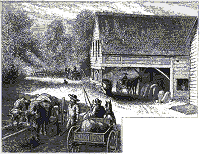 |
About a century ago, a man named Bishop, with a
baker's dozen of children, came down from Delaware County - curiously
enough - to settle here. The space about these falls was all
"commons", and Mr. Bishop bought a large tract on one side
of the river for a few cents an acre. His first move was to take
advantage of the magnificent water-power, and erect a small mill,
building so well that the solid oaken timbers stand to-day as firmly
as when first put up, but browned by the lights and shadows of the
long years which have soaked into their pores. The first machinery,
an undershot wheel and simple gearing, was made entirely out of wood
whittled out by Bishop himself; where he got his buhr-stones, or
whether he had any, I do not know. |
|
These contrivances lasted some years, but one
winter, were torn away by the ice. Then a workman from Kingston made
a wooden tab-wheel. This also stood a long time, but a few years ago
was replaced by a turbine wheel, and the primitive gearing by the
iron-shafts and cog-wheels in present use. Meanwhile, under the
ceaseless turning of the stream of life, the owner wore out along
with his wheels, and Mr. Bishop was laid aside. Some would think this
pioneer might have said "My life is one dem'd horrid grind";
but we have no record that he even thought of his stay on this earth
thus harshly.
The history of this old mill thus suggests the
history of the whole region. The first settlements upon this
territory, as I gather from the farmers while they smoked their pipes
in the evening twilight, were made about 1740 upon the flats along
the Esopus, just below Shokan. One of the first settlers was a man
named Mattagh, and there is a crumbling tombstone now in the burying-ground
near the old Olive Bridge on which the name Mattagh and the date
1740 still appear, though almost illegible. The earliest families
seem to have come from the Mohawk Valley and Delaware County, and
their family names still remain among the most respectable people of
the town. This fertile valley, and the game-abounding hills, were
then occupied by the Indians, who often resisted by force of arms the
cool seizure of their ancestral fields by white men who came unasked. |
|
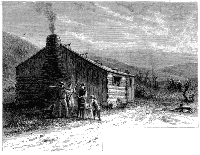 |
After the Revolution, this part of the country
began to fill up, but it was not until 1832, when the Middletown
turnpike was put through, that any progress of importance began to be
made. Earlier than that, however itinerant preachers organized
churches in this region, and curious stories are told of some of the
pioneer pastors - men of the old hammering orthodox stamp, fearless
in the denunciation of vice and iniquity in every form, holding no
parley with sin, resolute, determined, and indefatigable in the
discharge of every religious duty. One was blind, another rode his
circuit after he was eighty years old, and a third would preach with
the stone-mason's apron on in which he had begun earning his bread
during the week. |
|
The old mill, in its stability, regularity, and
slow movement is not a bad type of the men who bring their harvests
to be crushed, and while waiting grind between the stones of each
other's comments the grist of neighborhood gossip. They differ mainly
in the cut of their coats, from those who came when the old mill was
new, for they have preserved the traditions and customs of their
forefathers with great tenacity. Their faces show the mixture of
Yankee and Dutch blood which flows in their veins, and the thrift in
their farming and their incessant whittling further attest the double
parentage. All the farms have been in the families of those who now
own them for several generations, but still yield abundantly. The
aged orchards, the pieces of large second-growth timber, the
occasional ruin where once stood a homestead, the many low,
old-styled, tumble-down stone houses, show how long the valley has
been under the plow. The simplest mechanical arts never had much
foot-hold here, for every young man prepares himself to live a Crusoe
life, learns all the trades as well as the methods of agriculture,
and by the time he is twenty-four is supposed to be proficient in
every handcraft likely to be of use to an independent farmer. He is a
wheelwright, a blacksmith, a house-carpenter, a stone-mason, a
shoemaker; can patch his harness, repair his gun, or intelligently
tinker the few pieces of machinery which have forced their way from
the outside world of labor-saving inventions into these quiet
precincts. You find a workshop on every farm, and a more or less
complete set of tools for each of the trades. The cutting and
splitting of hoop poles occupies profitably many a rainy day, after
the farmer has seen that his hoes lack no handles and his ox-yoke
does not need a new bow.
On the other hand, the women are skilled in all
those household industries which were considered the accomplishments
of the Puritan maidens, and are slow to displace the spinning-wheel
by the sewing machine. Of course the testimony of their proficiency
as cooks is "new every morning and fresh every evening". In
the long August afternoons, when the mellow sun glances upon the
circles of ruddy cider apples under the broad orchard trees, and the
cat drowses on the door-step, guarding the immaculate kitchen from
the invasion of the chickens is heard the loud rhythmic purring of
the spinning-wheel, rising and dying away like the droning of the
giant bee. Watching the plainly attired woman walking back and forth
beside her whirring wheel, guiding with dextrous hands the fleecy
lengths she holds, one can easily think himself back in the "good
old colony times", when the matrons paused in their spinning to
chat of the news brought in the last ship from England, or guided
their yarn with tremulous hands and beating hearts, while their
lovers watched them through the misty spokes of the flying wheel.
The carding bee has been outgrown, but the idea
remains, and the people still find their pleasures in combining play
with work; husking bees, quiltings, and raisings are yet the
enthusiastic occasions of tremendous labour and equal fun. In the
fall there is an occasional nutting party, or hunt for wild honey by
"lining" the bees home to their treasure. Hundreds of
pounds of fine honey are thus got every year out of these woods.
Another set of mountaineers, the bears, are also good bee hunters,
and thus betraying themselves, often become the preferred objects of chase. |
|
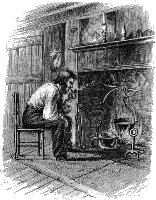 |
The bear hunter par excellance and the
"character" of the township is Enos Brown, in whose
hospitable cabin I enjoyed many an hour of rest and invigoration. He
is a pioneer of such stuff as our frontiersman are made, and although
wasting no time in long migrations or useless efforts to keep in the
forefront of our nation's western picket-line, he has kept himself
equally in the wilds by driving his stakes in a spot so unpropitious
for "modern improvements" that civilization has divided and
gone around him. He was born among these hills, and when a young man,
just married, he and his wife were employed to go back into the
wilderness and cook for a gang of bark-peelers, who were stripping
the hemlocks for the great tanneries below. |
|
A rude shanty, partly of logs and partly of
boards, one end filled with a huge stone chimney and fireplace, in
which the crane still hangs and serves its daily use, was built on a
little plateau up at the head of Traver's Hollow, 1800 feet or so
above the level of the Hudson, and the Enos and his wife made a home
for the men for several seasons. At last the bark was exhausted, and
the place was abandoned by the peelers; but Brown had taken root and
buying the adjacent land "for a song", he has remained ever
since in the same shanty, which now he "kalkilates wants a new roofin".
|
|







